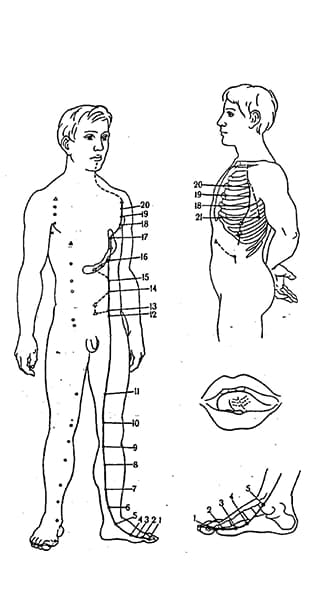
The Spleen and Pancreas Meridian (RP)
The meridian of the spleen and pancreas belongs to the system of the Yin meridians. Its pair is the stomach meridian, and its element is earth. It receives energy from the stomach meridian and transmits it to the heart meridian. The maximum meridian activity is from 9:00 to 11:00 am, and the minimum activity is from 9:00 pm to 11:00pm.
Functions of the Spleen and Pancreas Meridian
Meridian controls the promotion and assimilation of food, the preservation of nutrients, affects the work of the lymphatic system, the deposition of fat accumulation and metabolism. The spleen is designed to convert and further promote nutrients, regulate body fluids and control blood. He oversees muscles and 4 limbs. The key to diagnostic understanding is the mouth. Her shine is evident on the lips.
Transportation and transformation of nutrient substances: the spleen absorbs the assimilation of nutrients and transmits them further throughout the body to nourish 5 dense and 6 hollow organs, 4 limbs, 100 bones, skin, hair. In case of violation of these functions, there is: flatulence, diarrhea, fatigue, weight loss, and the phenomenon of insufficiency.
Transportation and digestion of water and moisture: the spleen promotes the exchange of fluids in the body. When these functions are violated due to “water constipation”, various diseases occur (the amount of mucus in the body and sputum production may increase, diarrhea may occur in the formation of mucus in the intestines, ascites in the abdominal cavity).
The spleen is the source of qi-hui formation (the active beginning of blood) — the function of restraining blood flow, if qi is weak, then it loses its ability to restrain, blood protrudes from the vessels and leads to various bleeding.
The meridian of the spleen-pancreas begins at the big toe, then rises along the inside of the foot, goes on along the inside of the shin, knee joint, hip, and it reaches the groin. Along the trunk, the meridian passes from the groin along the lateral surface of the peritoneum, chest, rises slightly before reaching the collarbone, and descends in the armpit area at the sixth hypochondrium (spleen area).

Symptoms and Diseases Related to the Imbalance of the Spleen and Pancreas Meridian
A sign of redundancy
Nausea, food intoxication, belching, feeling of overflow in the abdomen, unstable appetite, constipation, feeling of heaviness in the hypochondrium and pain, as well as restriction of movement of the first toe, pain in the joints of the legs, heavy sleep.
A sign of insufficiency
Frequent bowel movements, poor digestion, vomiting, gas in the stomach, pain in the epigastric region. Skin disorders, venous congestion in the legs, weakness, drowsiness during the day, numbness of the legs.
Diseases of the spleen and pancreatic meridian
Diseases associated with the meridian of the spleen: bloating, vomiting, diarrhea, uterine bleeding, amenorrhea, cold feet, gouty pain, loss of consciousness, convulsions in children, nightmares, vomiting, stomach cramps, constipation, pain in the foot and ankle, fever, high body temperature, hemorrhoids, redness and swelling of the foot, convulsions, anxiety, signs of spontaneous termination of pregnancy, angina, tachycardia, jaundice, pain in the tongue, infertility, pathological childbirth, orchitis, difficulty urinating, hernia pain, paresis and paralysis of the lower extremities, fatigue, neurasthenia, psychasthenia, increased intestinal peristalsis, lack of appetite, ascites, hip and knee pain, menstrual disorders, itchy rash on the inner thigh, trophic leg ulcers, urinary incontinence, inflammatory processes in the groin, cough, chest and hypochondrium pain, shoulder pain, intercostal neuralgia, hiccups, decreased lactation, discharge of thick purulent sputum, shortness of breath.